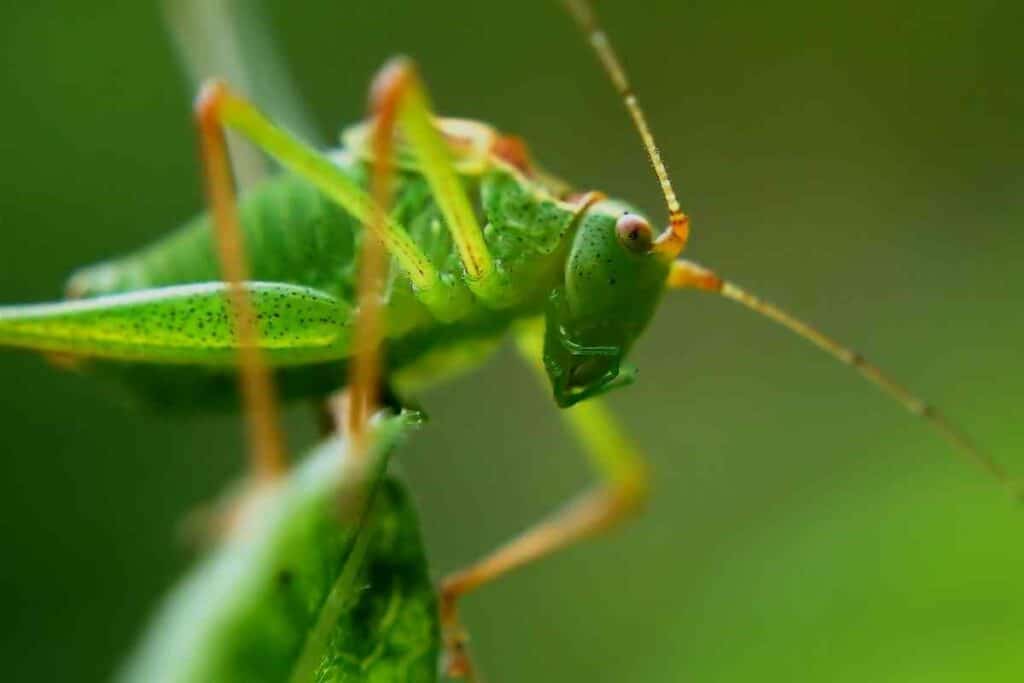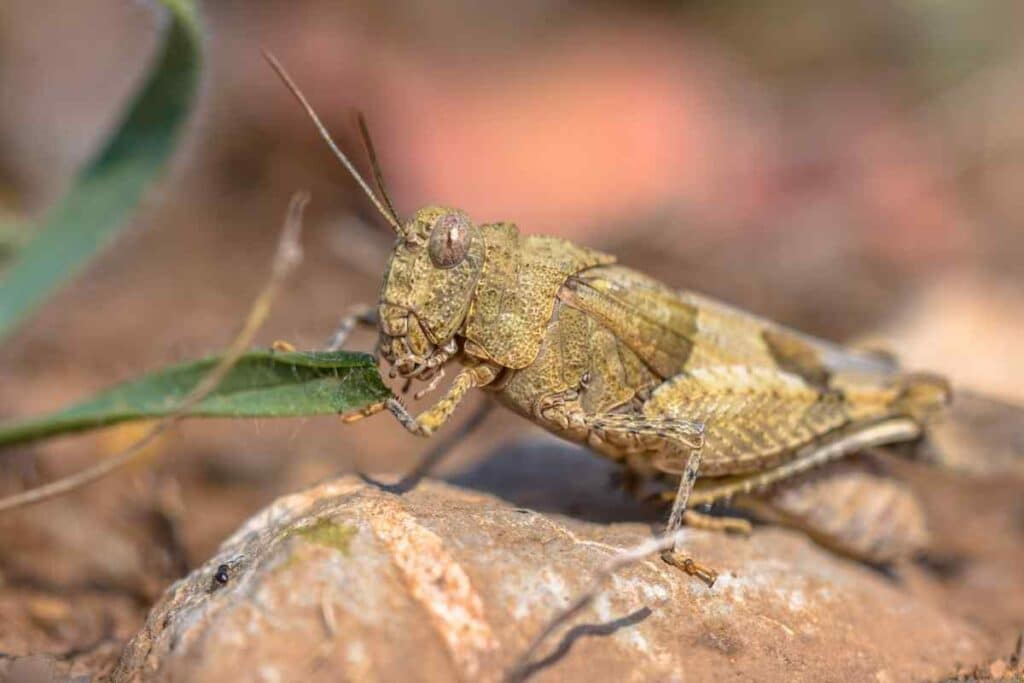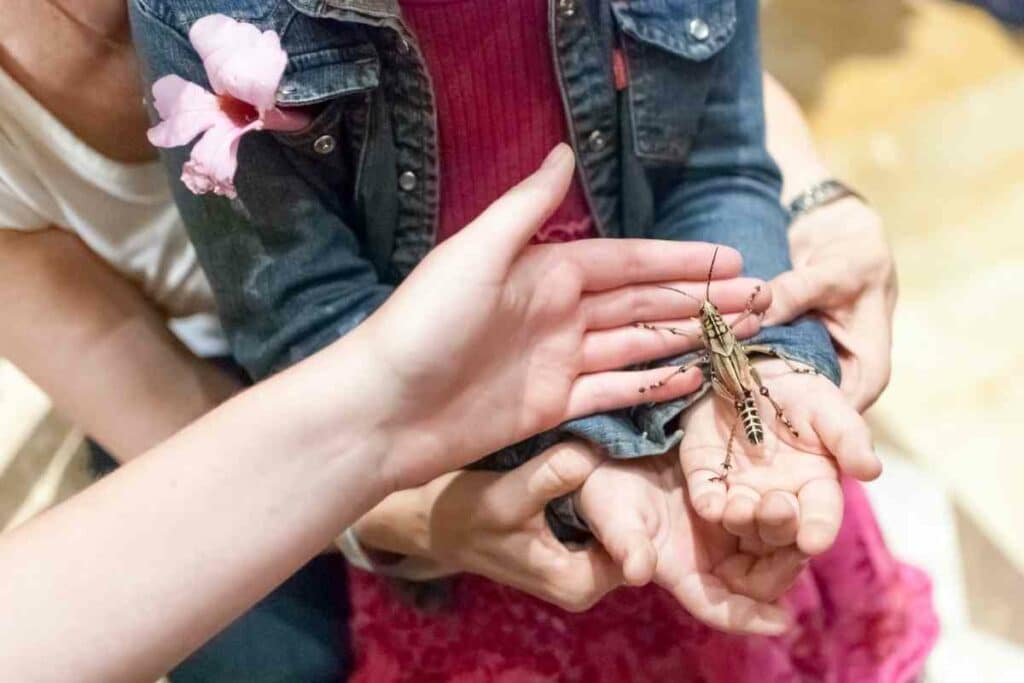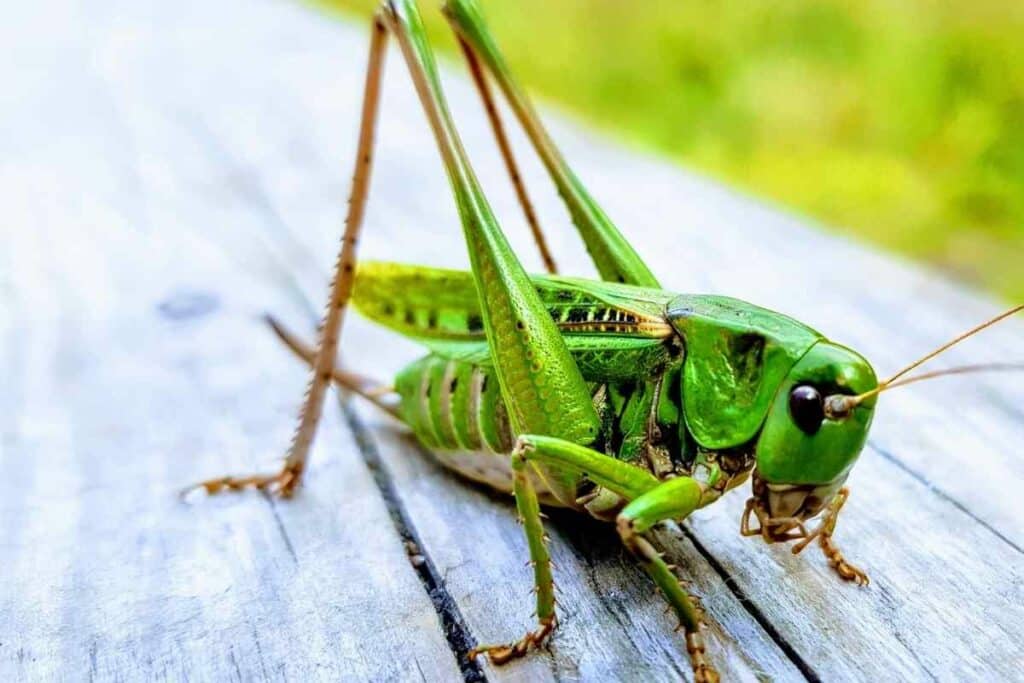Grasshoppers are herbivorous insects renowned for their ability to jump long distances. The most common type of grasshoppers is locusts.
Despite being small, most grasshoppers are destructive. These insects eat half of their body weight daily and primarily target plant stems and leaves.
If you don’t take any action, the damage may become so severe that your whole crop dies.
Fortunately, you can deal with these pests and prevent damage to your crop.
However, you need to understand the life cycle, preferred habitat, and other behaviors of the grasshopper.

The Life Cycle of Grasshoppers
All grasshoppers, both beneficial and destructive, have a similar life cycle.
They undergo an incomplete metamorphosis, meaning that there’s no larval stage.
Instead, the egg hatches a nymph that molts for several weeks before maturing into an adult insect.
Grasshoppers usually lay eggs in summer and bury them in soil.
The eggs remain in the ground for months and go into diapause during the cold months. They start hatching on the onset of spring.
After emerging from the eggs, grasshopper nymphs start feeding on plant material.
These organisms feed voraciously and migrate into new areas after exhausting the current region.
It takes one to two months for grasshoppers to reach adulthood.
During this period, they continue attacking your crop.
This persists through winter when the cold weather overwhelms and kills them.
What’s the Preferred Habitat for Grasshoppers?
Grasshoppers are highly adaptable species that can survive a broad range of climates.
However, they thrive best in warm and dry areas with low-lying vegetation.
What Do Grasshoppers Eat?
As mentioned earlier, grasshoppers feed on plant matter, mainly stems and leaves. They primarily target grasses and broadleaf crops.
After hatching, the nymphs stay near the hatching area until they exhaust the food supply.
When this happens, they migrate to other locations.
It’s worth noting that nymphs can’t travel over long distances because they lack wings.

What Are the Signs of a Grasshopper Infestation?
Here are some of the signs that your garden is under a grasshopper infestation.
- Damaged stems and leaves – the most obvious indicator of a grasshopper infestation is damaged leaves and stems, as these are their preferred meal. If you see holes in leaves, it’s time to employ countering measures.
- Grasshopper eggs and nests – when inspecting your farm, look for eggs in the soil. Take prompt action if you notice any nests.
- Skid marks on plants – this is another sign of a grasshopper infestation.
How to Get Rid of Grasshoppers
Before you embark on eradicating grasshoppers, it’s worth noting that these insects are helpful to the ecosystem.
They are food for other insects, birds, lizards, etc. Also, they add nutrients to the soil when they excrete.
If your garden has a few grasshoppers, there’s no need to take stringent action.
Otherwise, here are the methods you can use to curb hoppers in your garden.
Environmental Grasshopper Control
Do you know that you can use the environment to curb a grasshopper infestation?
You can do this by making the garden unattractive or creating conducive conditions for grasshoppers away from your garden.
How? Read on to discover.
Plant unattractive flowers
Planting flowers that grasshoppers find unattractive is a smart way to keep insects at bay.
By adding such flowers to your farm, you protect your crops against attacks.
Hoppers don’t like flowers like Artemisia, Forsythia, Crepe Myrtle, Lilac, Dianthus, and Moss Rose.
Grow inedible vegetables
In this case, ‘inedible’ refers to the vegetables that grasshoppers don’t eat. Such include peas, squash, and tomatoes.
Besides acting as grasshopper repellents, these plants can be a source of food and extra income.
Plant tall grass on the periphery
As mentioned earlier, grasshoppers like eating and living in tall grass.
You can stop these insects from attacking your crops by deliberately planting tall grass around your farm.
This, coupled with regular weeding, is an effective way of keeping these pests away from your plants.
Organic Grasshopper Control
Another effective method of eliminating grasshoppers involves using organic materials such as neem, garlic, and hot pepper wax.
What we like about these methods is that you can make them yourself.
Garlic Spray
Grasshoppers don’t like the strong scent produced by garlic.
When you mix ground garlic with water and apply it over your plants’ leaves, the insects will stay away from your farm.
It’s advisable to prepare a concentrated solution to cover a large area when diluted.
You’ll need a pressurized sprayer for the practical application of this remedy.
Although you can get this product at your local agro-vet store, you can also make it yourself.
Hot Pepper Wax
Like garlic, hot pepper also has an odor that grasshoppers find unpleasant.
Its main ingredient, cayenne pepper, is so bitter that the insects can’t taste a leaf with its traces.
For this reason, it helps to apply hot pepper on plants that are prone to grasshopper infestation.
Neem Oil
The Neem tree and its products are a popular home remedy to many issues. For example, its oil serves as a fungicide and pesticide.
This oil repels the insects and interrupts the egg-laying cycle regarding grasshopper control.
Even better, the oil inhibits feeding, which leads to retarded growth among grasshoppers.
Pesticidal Soap
Organic pesticidal soaps contain fatty acids that dehydrate grasshoppers before dissolving their bodies.
However, it’d be best to be careful when applying this soap because it can damage your plants.
Vinegar
Vinegar contains a variety of natural chemicals that can repel grasshoppers. You can spray it directly in the leaves if you have a small garden.
For large-scale projects, mix vinegar with soapy water before spraying.

Biological Methods of Grasshopper Control
If you can’t access organic material, you can use other animals to handle your grasshopper problem.
Here, you introduce natural predators that feed on the insects to your farm. These include;
Chicken, Ducks, and Geese
Chicken, ducks, and geese like feeding on grasshoppers and other insects.
What’s more, eating such pests diversifies their diet and makes them grow faster while solving your infestation problem.
Wild Birds
Like their domestic counterparts, wild birds also enjoy feasting on grasshoppers and other small bugs.
You can take advantage of this by ‘inviting’ them to your garden.
Adding posts, logs, and other structures to perch as they feed on the hoppers.
Chemical-based Grasshopper Control
Although it’s more effective than other methods, many people don’t like using chemicals to eliminate grasshoppers.
Pesticides affect food quality and cause complications when inhaled or ingested.
Carbaryl is the most efficient chemical pesticide for eradicating grasshoppers.
Unfortunately, this chemical hurts beneficial insects.
As such, it’s safer to use baits containing carbaryl than spraying it on the plants to protect bees and other beneficial insects.
When spraying chemical insecticides, it’s wise to target breeding sites and nymphs in spring and early summer.
Because most of these treatments have unpleasant smells, add canola oil to the sprayed plants to attract the grasshoppers.
When spraying your crops, ensure that you have the proper protective gear.
More importantly, don’t harvest the crop until the period recommended by the pesticide manufacturer elapses.
Other Methods of Grasshopper Control
Here are other methods used to combat grasshopper attacks.
Most of them use the DIY approach.
Flour dust
Flour dust and ashes can reduce the number of grasshoppers attacking your crops.
The problem with this method is that it only limits the grasshopper population but doesn’t stop the damage.
Due to this reason, you should only use it in small gardens.
Covering your plants
If your farm suffers a grasshopper infestation, covering your plants can help it stay that way.
You can use a fabric barrier or floating row cover to do this.
Ensure that the cover doesn’t touch the plants, as this can ‘suffocate’ them.
Use hoops to maintain a distance between the cover and the plants’ apexes.
Also, ensure that the air openings on the cover are too small to allow grasshoppers through.
Till your farm in spring
As you know, grasshoppers lay eggs in summer and bury them in the soil through autumn and winter.
The eggs usually hatch in spring. You can interrupt the life cycle by tilling your land in early spring.
This destroys the eggs and prevents hatching.
Kaolin clay
One of the newer methods of eliminating grasshoppers involves using Kaolin clay.
When you mix the clay with soap and water and spray it over your plants, it leaves a thin film that protects against these insects.
Despite its effectiveness, many people don’t like the unsightly mess that Kaolin clay creates.
Moreover, it would be best to wash your harvests thoroughly to remove the clay leaves coating your green vegetables.
Diatomaceous Earth
Diatomaceous earth is a popular pest control additive made using the shells of fossilized algae. It kills soft insects through dehydration.
You must wear protective gear when applying diatomaceous earth.
Ensure your nose and mouth are covered, as inhaling this product has adverse effects.
Also, avoid touching your eyes because it leads to irritation.
You can apply this product as dust or mix it with water and spray it over your plants.
It only becomes effective when the water evaporates and leaves a coating on the leaves when sprayed.
Nolo Bait
Nolo Bait is a single-cell organism that infects and kills grasshoppers at every stage of their life cycle.
It is particularly effective at eliminating locusts (Nosema locustae), the most prevalent grasshopper species.
It also hurts some crickets, but the results aren’t as devastating as with locusts.
Timing is the most crucial aspect of Nolo bait application.
Specifically, you must apply the bait when the eggs are hatching into nymphs.
Otherwise, the effectiveness of the treatment will be useless.
The best time to use Nolo bait is when the nymphs are no more than ¼” long.
The young hoppers will consume the bait and die of blood poisoning.
Later, the surviving bugs will feed on the dead ones and become sick.
As seen above, it takes one infection to hurt an entire swarm of locusts.
This makes Nolo bait one of the most efficient means of eliminating grasshoppers, especially if you have a large farm.
Even better, it is environmentally friendly.
Moth Balls
Mothballs are infamous for their pungent smell.
The odor they produce is enough to keep grasshoppers away from your crops. You can find this product at your local grocery store.
Keeping Grasshoppers
Some people like keeping insects as pests, and grasshoppers are viable because they are inexpensive and don’t require special food.
Here is a short guide on petting grasshoppers.
Finding a Grasshopper
- Grasshoppers are available throughout the year, except in areas that experience cold winters.
- You are most likely to find a grasshopper in grassy fields.
- Use a fine mesh net to catch the insects, and then transport them in a glass jar with a few openings to let in air.
Housing a Grasshopper
- Invest in a plastic or glass terrarium for keeping your pet. It should be big enough to allow the insect to move freely.
- Fill the bottom of the terrarium with dry coconut fiber, dry oatmeal flakes, or sand. This makes the home more comfortable for the grasshopper.
- Ensure that the terrarium is warm and receives adequate light. Grasshoppers need at least 25 degrees of heat to thrive. You can install a light bulb during the cold months to increase warmth.

Feeding a Grasshopper
- Grasshoppers primarily feed on grass. For the best results, mix different types of grasses. For instance, you can take some from your lawn and others from the wild.
- Spray the leaves with water before feeding the insects. This provides them with the water they need to survive.
- When harvesting grass, ensure that you pick from areas that haven’t been sprayed with pesticides or any chemicals, as these can kill your grasshopper.
- Avoid overfeeding your grasshopper. When you spot any food remains, remove them to keep the terrarium clean.
Breeding Grasshoppers
- Ensure that you have enough food supply.
- Keep the insects in a warm terrarium with low humidity.
- Breeding occurs naturally if you have males and females.
- You don’t have to move the nymphs to a different container. However, it’s recommended because it allows you to cater to their specific needs.
Frequently Asked Questions about Grasshoppers
Do Grasshoppers Hibernate?
In areas that are extremely cold during winter, grasshoppers overwinter as eggs.
Adult females lay eggs beneath the soil using an ovipositor.
After laying the eggs, the insect buries them into the soil to keep them warm during the cold months.
It’s worth noting that adults don’t survive harsh winters.
Interestingly, nymphs can find a warmer spot and stay there until the conditions outside become favorable.
In areas with mild winters, grasshoppers remain active because food is usually available and the conditions are accommodating.
The insects can survive as eggs, nymphs, or adults in such places.
Are Grasshoppers Dangerous?
Grasshoppers aren’t dangerous, as they don’t bite or carry pathogens.
Despite the damage they cause to crops, they play a vital role in the ecosystem and environment.
Can a Grasshopper Regenerate Lost Legs?
A grasshopper can shed one or both of its hind limbs when attacked by a predator or involved in an accident.
However, these limbs don’t grow back once lost. This process is known as autotomy.
When a grasshopper loses its legs, it severs the body’s nerves to the lost limbs.
Notably, this doesn’t affect the tissues around the lost limb.
After a week, the muscles that supported the lost legs shrink because they no longer have use.

Do Grasshoppers Need Water to Survive?
Grasshoppers need small amounts of water to survive.
They get this from the moisture on plant leaves.
Do Grasshoppers Pee and Poop?
Yes, grasshoppers urinate and defecate. However, they do so in small amounts that look like tiny dots.
Do Grasshoppers Sleep?
Grasshoppers sleep, albeit in short periods. They don’t close their eyes and appear awake while sleeping.
Because they are primarily nocturnal, these insects usually sleep during the day.
Their preferred sleeping areas include tall grass, trees, and rocks.
Wrapping Up
Grasshoppers are considered mainly pests because of their destructiveness.
These insects can undo several months of hard work within a few days.
For this reason, it’s vital to employ preventative measures and protect your crops against their attacks.
Read this grasshopper field study we found. It’s very interesting and packed with information.
By creating unfavorable conditions, such as tilling the ground, eliminating weeds, and using mothballs, you’ll be able to stop crop destruction.
The other measures, such as applying chemical pesticides, should be the last resort.
On the contrary, some people like keeping grasshoppers as pets.
If you’re an insect enthusiast, ensure that you create a conducive environment for breeding and provide proper housing and adequate food.
More importantly, ensure that your pets don’t attack others’ property when you eventually release them into the wild.


